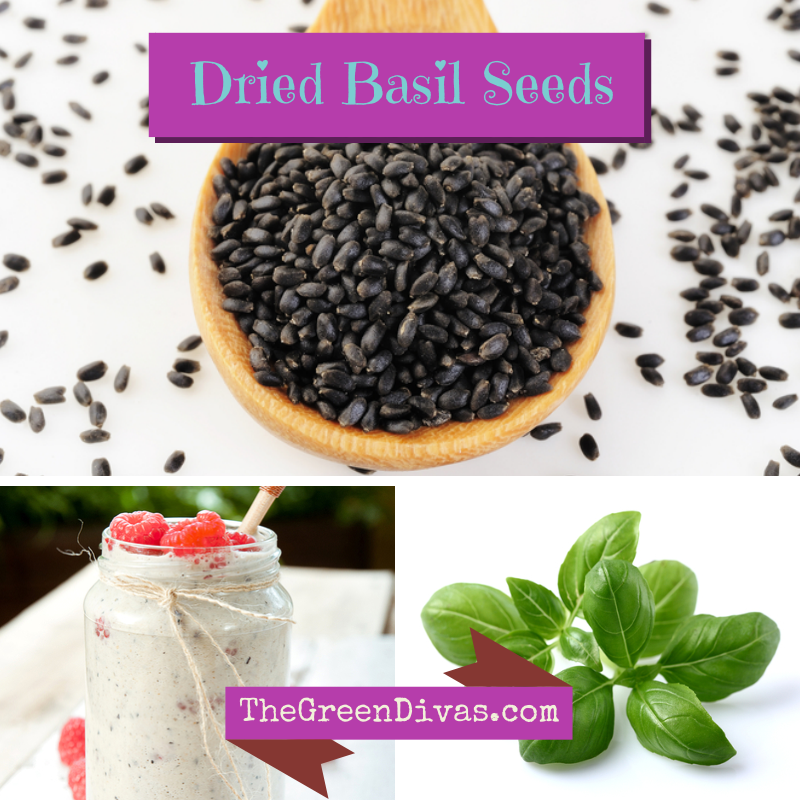This post was written by Green Diva Lisa to accompany her latest GD Foodies segment. Listen to this interesting GD Foodies segment about dried basil seeds, then read on to learn lots more about dried basil seeds AND get a couple of great recipes!
Recently I was wandering through an Asian market and came across Dried Basil Seeds. In my haste, I thought it just said basil seeds. Hmmm, maybe they were for sprouting, or at the very least I could plant them? So I bought them and when I got home saw the “dried” on the label.
Like any self-respecting Green Diva, I googled it and learned that they act much like my beloved chia seeds. Like most seeds, they are chock full of nutrients and are considered by some to be a super food. One difference, (that I liked) is that the basil seeds plump up in minutes, whereas the chia seeds may take hours. And I really like the tapioca texture of these seeds. Just because they aren’t as “trendy” yet, doesn’t mean they aren’t fabulous.
Here are a few things that I learned
- These seeds are also called sabja seeds, Arabic falooda seeds, Thai holy basil (which is apparently different from holy basil), Tulsi, selashi and turmaria. And are best known around the world for being the main ingredient in many sweet Asian drinks.
- They are often used in Ayurvedic and Siddha medicine in India and also Chinese medicine.
- They plump up just like chia seeds and can be used interchangeably in most recipes. I even throw them in my morning smoothies. Like chia seeds they don’t have much flavor which also makes the versatile.
- Some of the health benefits:
- Cooling – they are cooling which is why they are added to many cool drinks like falooda, rood afza, nimbu pani and sherbets.
- Colds etc. – they are good for sore throats, cold and respiratory disorders.
- Aid digestion – they can help in digestion and cure constipation.
- Stress relief – they can have a calming effect and can uplift your mood.
- Skin relief – they are good for skin infections.
- Weight loss – they can curb your appetite if you consume them in a gelatinous drink before a meal.
Nutritional benefits of Basil seeds
- Basil contains many polyphenolic flavonoids especially Orientin and Vicenin. These provide the antioxidant benefits.
- Basil leaves are rich in many essential oils like eugenol, citronellol, linalool, limonene, citral and terpineol. These provide antibacterial and anti inflammatory benefits.
- Low in calories and free of cholesterol.
- High levels of beta carotene, lutein, zeaxanthin, Vitamin A and Vitamin K.
- Contains good amounts of minerals like potassium, manganese, copper, calcium and magnesium, and vitamins C and folates.
- Excellent source of iron at 40% RDA per 100 grams.
Here an article that is very thorough about the specific benefits of basil seeds.
How to prepare basil seeds
Using ½ – 1 cup of a warm (not hot) liquid of your choice, water or juice; add 2 tsp. of dried basil seeds. After the seeds swell, you can choose to drain extra liquid or include it. As the seeds plump up, they will begin to release their antioxidants and digestive enzymes. Let the seeds stand in the liquid for at least 2 minutes, and watch them transform into a gelatinous-tapioca like texture. They will be ready to include in your favorite recipe. You are only limited by your imagination.
Collecting seeds
You can collect these seeds from your own basil plants. Let the basil flower bloom, wither then dry. When the flowers are good and dry you can put the flowers on something flat and gently blow the debris away and collect the tiny black seeds. They are fully mature when they easily detach from the flowers.
Warning
Always watch children and the elderly when drinking basil seed drinks. The seeds may clump together which could cause choking if not enough liquid is used to make the drinks. Pregnant women or those trying to conceive should not use basil since it lowers the levels of estrogen.
[yumprint-recipe id=’23’]
Please check out our YouTube channel to see our short, funny and useful 1 GD Minute videos with recipes and DIY tutorials. Here’s a recent one…
And if you want to learn more about the content of this video, please read the corresponding post!
Bonus:
Listen to the latest from the GD Podcast Network …

Deborah Davis
March 20, 2014 at 12:28 pm
It is so intriguing to learn how healthy basil seeds are!
I can’t wait to make this Lemony Basil Seed Drink as well as the Pudding. Thanks for enlightening us! I am going to share this exotic new tidbit!
Nilofer
June 29, 2016 at 6:29 am
I want to know the amount of nutrient content present in the basil seed and also I want to know that ,whether the basil seed is used in the powdered form or not?
Sophia
July 2, 2017 at 12:56 pm
I have been searching high a low for the data on nutrients found in basil seeds and can’t find any. Do you know what the nutrient profile is?
Green Diva Meg
July 2, 2017 at 1:09 pm
Hi Sophia. If you search “nutrient profile of basil seeds” you will find several good sites that have details on this.